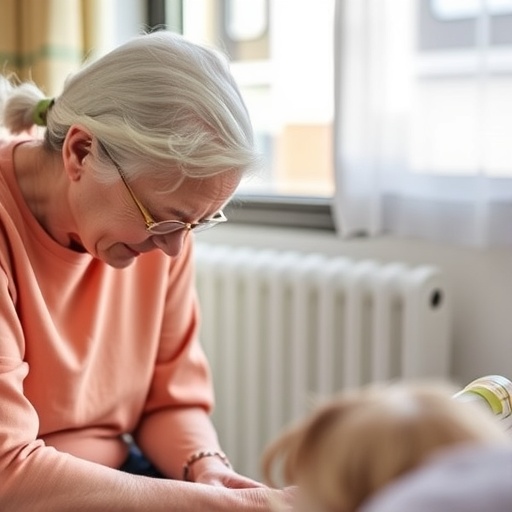Antibiotic resistance has become a critical global health concern, particularly in vulnerable populations such as the elderly residing in nursing homes. Recent research led by Hansen et al. focuses on the appropriateness of antibiotic use for suspected urinary tract infections (UTIs) across five European countries, shedding light on variations in prescribing practices. The study highlights the complexities and challenges inherent in diagnosing and managing UTIs in nursing home settings, where patients often present atypical symptoms that can confound traditional diagnostic criteria.
As we dive into this research, it’s crucial to understand the backdrop against which this study is set. The elderly population is particularly susceptible to infections due to a combination of age-related physiological changes, comorbidities, and often, a weakened immune system. UTIs are among the most prevalent infections in nursing home residents, resulting in significant morbidity and health care costs. Despite the known risks of inappropriate antibiotic use, there remains a tendency for overprescription, driven by both clinical uncertainty and systemic factors within healthcare systems.
This research illuminates the stark disparities in antibiotic prescribing practices across the five countries involved in the study—each with its own healthcare policies, antibiotic stewardship programs, and cultural approaches to healthcare delivery. By analyzing data from different regions, the researchers were able to illustrate how local practices impact the overall management of UTIs, raising important questions about the standardization of care and the implementation of evidence-based guidelines.
One of the central findings of the study was the correlation between the availability of robust diagnostic tools and the appropriateness of antibiotic prescriptions. In nations where rapid diagnostic tests are readily accessible, there is a lower tendency to prescribe antibiotics without sufficient evidence. Conversely, in regions with limited diagnostic resources, practitioners often resort to empirical treatment based on clinical suspicion alone, which contributes to unnecessary antibiotic use. This underscores the need for investments in diagnostic technologies, particularly in resource-limited settings.
The study also highlighted the role of healthcare professionals’ training and awareness in influencing antibiotic prescribing behavior. In many nursing homes, staff may not always have access to the latest clinical guidelines or may lack the training necessary to effectively manage suspected UTIs. By providing targeted education and resources for healthcare providers, it may be possible to improve the appropriateness of antibiotic usage, thus minimizing the risk of resistance development and treatment failures.
Another perspective presented in the research is the significance of patient and family dynamics in the decision-making process regarding treatment. Patients in nursing homes often rely heavily on healthcare staff for guidance, and their own understanding of infections and antibiotics can vary significantly. Communicating effectively with both patients and their families about the rationale for treatment choices is critical in fostering compliance and understanding. Furthermore, the reluctance to withhold antibiotics, due to fears of adverse health outcomes, can lead to overprescribing practices, which need to be addressed through education and better communication strategies.
Additionally, the paper discusses the systemic challenges that exacerbate the issue of antibiotic misuse in nursing homes. Issues such as high staff turnover, inadequate staffing ratios, and time constraints make it difficult for healthcare personnel to engage in thorough assessments of residents who present with symptoms of UTIs. These systemic barriers contribute to the continuation of practices that may not align with the best available evidence, prompting an urgent call for systemic reforms that prioritize quality over quantity in healthcare delivery.
A closer look at the socio-economic factors influencing antibiotic prescribing patterns reveals stark contrasts among the participating countries. The study points out that regions with higher levels of healthcare funding and resources often demonstrate more stringent antibiotic stewardship practices. These insights emphasize the need for policymakers to prioritize funding in areas that directly address disparities in healthcare quality and accessibility for aging populations in nursing homes.
As the world grapples with the implications of antibiotic resistance, the findings of this research call for concerted action from health policymakers, practitioners, and researchers. It advocates for the development and implementation of standardized protocols for UTI management in nursing homes, emphasizing the significance of culture-specific adaptations of these guidelines to enhance relevance and efficacy in different regions.
In conclusion, the research by Hansen et al. is a crucial step towards understanding the complexities involved in antibiotic use for UTIs in nursing homes across Europe. By identifying the factors that contribute to inappropriate prescribing practices, the study lays a foundation for further inquiry and action. The promotion of best practices in antibiotic management not only has the potential to improve health outcomes for vulnerable populations but is also essential for combating the global threat of antibiotic resistance. Future research and policy initiatives must continue to explore these dimensions, ensuring that healthcare systems are equipped to meet the needs of their aging populations with the highest standards of care.
Subject of Research: Antibiotic use in nursing homes for urinary tract infections across Europe.
Article Title: Correction: Appropriateness of antibiotic use in nursing homes for suspected urinary tract infections: comparison across five European countries.
Article References:
Hansen, M.B., Lykkegaard, J., Hansen, M.P. et al. Correction: Appropriateness of antibiotic use in nursing homes for suspected urinary tract infections: comparison across five European countries.
Eur Geriatr Med (2025). https://doi.org/10.1007/s41999-025-01300-1
Image Credits: AI Generated
DOI:
Keywords: Antibiotic resistance, urinary tract infections, nursing homes, healthcare policy, Europe.




